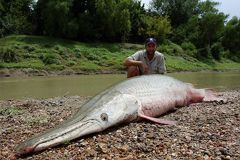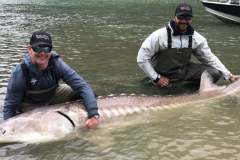Last month, researchers at the Leibniz-Institute of Freshwater Ecology and Inland Fisheries (IGB) published a paper, compiling 42 years of data that showed disturbing (putting it mildly) trends in the loss of large freshwater fish, reptile and mammal species around the world — up to 99% in some freshwater systems.
This is huge. And, importantly, is wayyy ahead of declines that have been occurring in either terrestrial or marine ecosystems.
Freshwater megafauna, defined by the researchers, are those achieving sizes of 30+ kg (66+ lbs) and include (among other animals) crocodiles, beavers, river dolphins, and fish, like sturgeon (which I have some personal experience working with). These animals are targeted by hunters/fishers for their meat, skins, eggs, etc. But, because they tend to mature at large sizes they are especially susceptible to over-exploitation and the risk of extinction.
The researchers compiled information on changing population sizes and distributions of 126 species from 72 countries between 1970 and 2012. And the conclusions were surprising, even to one of the study’s main authors, Sonja Jähnig, stating in the IGB press release: “The results are alarming and confirm the fears of scientists involved in studying and protecting freshwater biodiversity.”
The primary author on the study, Fengzhi He, was quoted by Nature (one of the leading scientific journals) as saying, “It is sadly a very shocking result.”
A global average of the combined megafauna species showed population declines of 88%. And the worst? Up to 99% in freshwater systems of the Indomalaya region in South and Southeast Asia and South China. Not to be outdone, aquatic species of rivers and lakes of Europe, North Africa and the larger part of Asia (the Paleartic region) have been walloped by 97% on average.
Large freshwater fish species seemed to have gotten hit even harder than other groups — 94% population declines (compared to reptiles at 72%). The brunt haven fallen on one particular species, the European sturgeon (Acipenser sturio), with a 99% loss of their distribution.
Sturgeons, as a group, are considered a Priority Species by the World Wildlife Fund, needing special attention due to their risk of extinction. Sturgeons are prized for, among other things, their eggs that are sold as caviar which, of course, not only kills the gravid (“pregnant”) female, but also prevents their spawn from ever contributing to the declining population. Double whammy.
Causes for the population declines are not terribly Earth-shaking, but are worth mentioning. The study pointed a finger at two problems:
1) Over-exploitation. As “Sean Parker” pointed out to “Mark Zuckerberg” in the Facebook biopic, The Social Network, “… ” Well, I don’t remember the actual quote, but the point was that people don’t usually go for the the little fish. They go for the BIG fish. And, as pointed out above, big fish tend to grow slowly. They tend to reproduce late in life. Targeting the big fish over and over and over has (clearly) shown its effect on those populations.
2) Habitat destruction. In freshwater, this is largely due to damming which cuts off migration and spawning routes of fishes. Hmmm… no spawning? I think the calculus on this part is pretty self-explanatory, but in case you missed it, imagine giving every 10-year-old girl a tubal ligation (or 10-year-old boys a vasectomy) and how that might affect the human population over the long haul.
One of the important points of the study (beside the shocking overall conclusions) was that the plummeting numbers of big freshwater critters far outpaces that of animals from either terrestrial or marine habitats — by TWICE the amount. Whoa!
Why? Well, the “summary” paper available to me didn’t get into those details. But pointing back to the two main causes, it’s not too much of leap to hypothesize that freshwater ecosystems are so close to our homes that they will be exploited at a higher rate (compared to marine species), and the species’ habitats inordinately affected by human population growth (which has, I will point out, doubled since my birth).
On top of that, freshwater species have been comparatively ignored in terms of conservation efforts, at least to large terrestrial species which are also close to our homes. As Jähnig points out, freshwater animals, “receive less research and conservation attention than megafauna in terrestrial or marine ecosystems.”
The original study was published as:
He F, Zarfl C, Bremerich V, David JNW, Hogan Z, Kalinkat G, Tockner K & Jähnig SC (2019) The global decline in freshwater megafauna populations. Global Change Biology.



